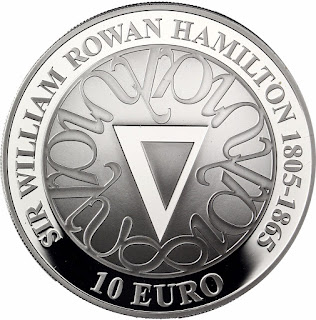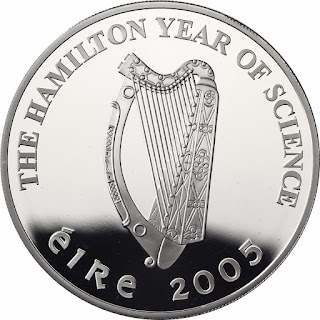Ireland 10 Euro Silver Coin 2005 Sir William Rowan Hamilton Birth 200th Anniversary
Sir William Rowan Hamilton Birth 200th Anniversary
The obverse depicts the Irish harp and the inscription "The Hamilton Year Of Science".
The reverse design features the nabla symbol surrounded by a decorative pattern formed from symbols and the inscription "Sir William Rowan Hamilton 1805-1865".
Face value: 10 Euro.
Designer: Micheal Guilfoyle
Alloy: Ag 925 Quantity: 30,000 Proof
Issued: 23/05/2005
Diameter: 38.61 mm
Weight: 28.28 g
Original Value: €32.00
Nabla symbol
The nabla is a triangular symbol like an inverted Greek delta: ∇. The name comes, by reason of the symbol's shape, from the Hellenistic Greek word νάβλα for a Phoenician harp, and was suggested by the encyclopedist William Robertson Smith to Peter Guthrie Tait in correspondence.
The harp, the instrument after which the nabla symbol is named. The Harp - a Symbol of Ireland.
Sir William Rowan Hamilton
Sir William Rowan Hamilton (midnight, 3–4 August 1805 – 2 September 1865) was an Irish physicist, astronomer, and mathematician, who made important contributions to classical mechanics, optics, and algebra. His studies of mechanical and optical systems led him to discover new mathematical concepts and techniques. His best known contribution to mathematical physics is the reformulation of Newtonian mechanics, now called Hamiltonian mechanics. This work has proven central to the modern study of classical field theories such as electromagnetism, and to the development of quantum mechanics. In pure mathematics, he is best known as the inventor of quaternions.
Hamilton is said to have shown immense talent at a very early age. Astronomer Bishop Dr. John Brinkley remarked of the 18-year-old Hamilton, 'This young man, I do not say will be, but is, the first mathematician of his age.'
Speech by Governor John Hurley at the launch of the Hamilton Commemorative Coin
Thank you, Provost, on behalf of the Central Bank, for hosting our launch in this beautiful room and for opening your home to us for the occasion. We are delighted to be here in Trinity College, which is so closely associated with the work of William Rowan Hamilton, to help commemorate and celebrate the year of the bi-centenary of his birth.Hamilton was renowned as one of the world’s greatest ever mathematicians and he spent his entire working life in the environs of Dublin. Born at midnight on 3rd August 1805 in Dublin, he was educated by his uncle, James Hamilton, an Anglican priest.
His genius was apparent at an early age. By the age of five he had already learned Latin, Greek and Hebrew and at the age of thirteen he could speak 13 languages. His pursuit of learning continued throughout his life. He studied and excelled at both classics and science here at Trinity College and at the age of twenty-one he was appointed Andrews’ Professor of Astronomy to the University of Dublin and Royal Astronomer of Ireland.
Hamilton’s work in the fields of optics and dynamics theory was rewarded with gold medals from The Royal Society of London and The Royal Irish Academy. Hamiltonian dynamics is important for almost every advanced physical science, and forms only part of his work that enlightened the world. His later work focused on pure mathematics and, in 1843, his mastery over symbols and mathematical language enabled him to solve a long-standing complex algebra problem. He devised the concept of ‘Quaternions’ while walking along the Royal Canal in Dublin and scratched his formula into the nearby Broom Bridge. Today a plaque on the bridge honours this discovery.
2005 is the UNESCO year of Science and in Ireland it is known as the Hamilton Year 2005 – Celebrating Irish Science. There are many events organised to celebrate and honour this true Irish genius and the Central Bank is delighted to be part of these celebrations by issuing this €10 Silver Collector Coin.
Mr. Michael Guilfoyle who is present here today designed this beautiful coin. Mr. Guilfoyle submitted the winning design to the national design competition held by the Central Bank last year. In his design Mr. Guilfoyle paid tribute to Sir William Rowan Hamilton’s use of algebraic equations that revolutionised mathematical physics. The gifted Irish scientist’s understanding of symbols and mathematical language is represented by a decorative circular pattern formed from these symbols. At the centre of the design is the NABLA, one of the principle symbols of modern mathematical physics. The symbol is so called because of its visual resemblance to the Egyptian harp of the same name. And, of course, on the other side of the coin, quite literally, is our own Irish harp, familiar to us all as a constant feature on all Irish coins.
This coin has been struck to the highest Proof quality in Sterling Silver and is restricted to only 30,000 pieces for issue worldwide. This is the third silver collector Euro coin that the Central Bank and Financial Services Authority of Ireland has issued. In 2003 we issued a €10 coin to mark the occasion of the Special Olympics in Ireland. Last year in 2004 we issued a €10 coin to mark the occasion of the accession of 10 new countries into Europe - a very historic occasion throughout Europe and one which Hamilton himself, with his great command of languages, would probably have embraced!
Both of these special coins sold out in a matter of months, with very big interest in them from both Irish and international coin collectors. I have no doubt but that this beautiful Hamilton €10 silver coin, which we are launching here today, will meet with similar demand. The coin will be available for sale to the public from next Monday, 23 May and we expect great interest in it.

